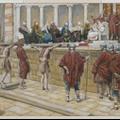BARCLAY: 1042
HAAG: Gabata
BROWNING: GABATA
ENSIKLOPEDIA: GABATA
MYSABDA: Gabata
Gabbatha
Dalam versi-versi Alkitab:
DJabata: LDKDRGabata: BIS KL1870 TB TL WBTCDR
Gabatha: ENDE
Gabbata: BABA SBDR
Gabbatha: KL1863
Yunani
Strongs #1042: gabbaya gabbatha
Gabbatha = "elevated or a platform"1) a raised place, elevation
++++
In the Greek was called Lithostrotos, or the pavement of stones,
as the Syrian version renders it: it is thought to be the room
Gazith, in which the sanhedrin sat in the temple when they tried
capital causes; and it was so called, because it was paved with
smooth, square hewn stones: "it was in the north part; half of it
was holy, and half of it was common: and it had two doors, one for
that part which was holy, and another for that part that was common;
and in that half that was common the sanhedrin sat." So that into
this part of it, and by this door, Pilate, though a Gentile, might
enter. This place, in the language of the Jews, who at that time
spoke Syrian, was Gabbatha, from its height, as it should seem;
though the Syrian and Persian versions read Gaphiphtha, which
signifies a fence or enclosure. Mention is made in the Talmud of the
upper Gab in the mountain of the house; but whether the same with
this Gabbatha, and whether this is the same with the chamber Gazith,
is not certain. The Septuagint uses the same word as John here does,
and calls by the same name the pavement of the temple on which
Israelites fell and worshipped God, 2Ch 7:3. (Gill)
The Hebrew word for Pavement occurs only once in the Old
Testament. In 2Ki 16:17 we read, "King Ahaz cut off the borders
of the bases, and removed the laver from off them; and took down the
sea from off the brazen oxen that were under it, and put it upon the
pavement of stones." In Ahaz's case his act was the conclusive token
of his abject apostasy. So here of Pilate coming down to the
apostate Jews. In the former case it was a Jewish ruler dominated by
a Gentile idolater; in the latter, a Gentile idolater dominated by
Jews who had rejected the Messiah! (AWP Joh 19:13)
1042 gabbatha gab-bath-ah'
of Chaldee origin (compare 1355); the knoll; gabbatha, a vernacular term for the Roman tribunal in Jerusalem: KJV -- Gabbatha.see HEBREW for 01355
Gabata [haag]
Gabata. (Barangkali berasal dari kata Aram: Tempat yang tinggi).
Nama sebuah ubin batu yang menjadi tempat landasan kursi pengadilan Pilatus (Yoh 19:13). Dengan kata ~G itu bukan dimaksudkan ubin di halaman benteng --> Antonia. Yang agak membingungkan adalah sebutan "panggung". Sebetulnya lebih sesuai dengan tempat yang tinggi di muka pretorium yang ada di dalam bekas istana Herodes.
GABATA [browning]
Dalam Yoh. 19:13 dikatakan bahwa nama adalah nama Ibrani (meskipun agaknya bahasa Aram) untuk tempat duduk *Pilatus di *pengadilan, yang dalam bahasa Yunani disebut Litos-trotos, yang berarti 'jalan yang dikeraskan dengan batu'. Seperti situs yang digali di Benteng *Antonia, di dataran yang agak tinggi sebelah utara Bait Suci Yerusalem ditemukan garis-garis, yang kemungkinan dibuat para serdadu untuk suatu permainan. Boleh jadi mereka bermain ketika Yesus diolok-olok (Yoh. 19:3). Di lain pihak, pendapat lain mengatakan bahwa jalan-jalan itu belum ada hingga zaman Adrianus (135 M).
GABATA [ensiklopedia]
(Yoh 19:13). Secara umum dianggap kata Ibrani atau Aram yg searti dengan kata Yunani lithostroton, 'hamparan batu' (bnd lantai mosaik, Est 1:6). Namun dari mana asal kata ini tidaklah jelas. Penggunaan kedua kata itu dalam Yoh 19:13 mungkin untuk menegaskan arti penting dari peristiwa yg, sedang terjadi (bnd Yoh 19:17, 20). Suetonius (Vit. Div. Jul.46) menceritakan bagaimana Julius Caesar dalam urusan kemiliteran membawa ubin-ubin berwarna-warni dan meletakkannya untuk menandai tempat-tempat di mana ketentuan-ketentuan hukumnya diberlakukan, tapi dalam Yoh 19:13 'Gabata' adalah tempat yg tepat. Menurut para sarjana, lokasinya adalah pada atau di dekat Menara Antonia (*YERUSALEM), di sebelah barat laut Bait Allah, dan Pere L. H Vincent mengatakan bahwa lokasi itu adalah pertapakan bagian lantai bawah gereja Dames de Sion yg ada sampai sekarang ini (lih Harper's Bible Dictionary, 1952, hlm 210). JDD/JMP
Gabata [MYSABDA]
 | Gabata location |
| Nomor Strong | : | G1042 |
| Kata Asli | : | Γαββαθά; Γαββαθά; Γαββαθᾶ |

dipersembahkan oleh YLSA


